KIA Spectra 2007 2.G Repair Manual
Manufacturer: KIA, Model Year: 2007, Model line: Spectra, Model: KIA Spectra 2007 2.GPages: 300, PDF Size: 2.91 MB
Page 61 of 300
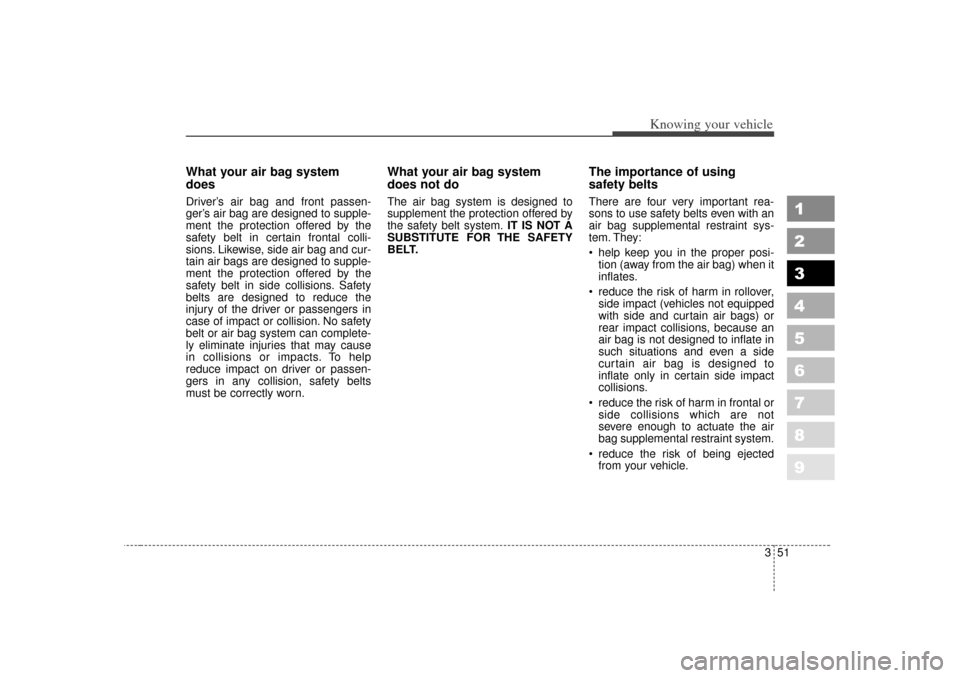
351
1
2
3
4
5
6
7
8
9
Knowing your vehicle
What your air bag system
doesDriver’s air bag and front passen-
ger’ s air bag are designed to supple-
ment the protection offered by the
safety belt in certain frontal colli-
sions. Likewise, side air bag and cur-
tain air bags are designed to supple-
ment the protection offered by the
safety belt in side collisions. Safety
belts are designed to reduce the
injury of the driver or passengers in
case of impact or collision. No safety
belt or air bag system can complete-
ly eliminate injuries that may cause
in collisions or impacts. To help
reduce impact on driver or passen-
gers in any collision, safety belts
must be correctly worn.
What your air bag system
does not doThe air bag system is designed to
supplement the protection offered by
the safety belt system. IT IS NOT A
SUBSTITUTE FOR THE SAFETY
BELT.
The importance of using
safety beltsThere are four very important rea-
sons to use safety belts even with an
air bag supplemental restraint sys-
tem. They:
help keep you in the proper posi-
tion (away from the air bag) when it
inflates.
reduce the risk of harm in rollover,
side impact (vehicles not equipped
with side and curtain air bags) or
rear impact collisions, because an
air bag is not designed to inflate in
such situations and even a side
curtain air bag is designed to
inflate only in certain side impact
collisions.
reduce the risk of harm in frontal or
side collisions which are not
severe enough to actuate the air
bag supplemental restraint system.
reduce the risk of being ejected
from your vehicle.
Page 62 of 300
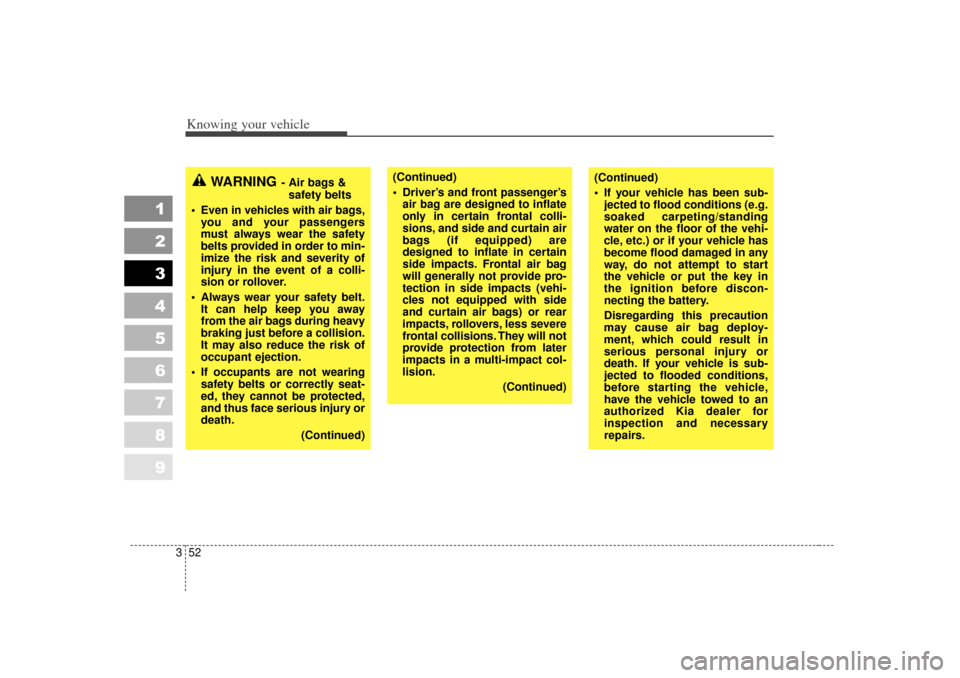
Knowing your vehicle52
3
1
2
3
4
5
6
7
8
9
WARNING
- Air bags &
safety belts
Even in vehicles with air bags, you and your passengers
must always wear the safety
belts provided in order to min-
imize the risk and severity of
injury in the event of a colli-
sion or rollover.
Always wear your safety belt. It can help keep you away
from the air bags during heavy
braking just before a collision.
It may also reduce the risk of
occupant ejection.
If occupants are not wearing safety belts or correctly seat-
ed, they cannot be protected,
and thus face serious injury or
death.
(Continued)
(Continued)
Driver’s and front passenger’sair bag are designed to inflate
only in certain frontal colli-
sions, and side and curtain air
bags (if equipped) are
designed to inflate in certain
side impacts. Frontal air bag
will generally not provide pro-
tection in side impacts (vehi-
cles not equipped with side
and curtain air bags) or rear
impacts, rollovers, less severe
frontal collisions. They will not
provide protection from later
impacts in a multi-impact col-
lision.
(Continued)
(Continued)
If your vehicle has been sub-jected to flood conditions (e.g.
soaked carpeting/standing
water on the floor of the vehi-
cle, etc.) or if your vehicle has
become flood damaged in any
way, do not attempt to start
the vehicle or put the key in
the ignition before discon-
necting the battery.
Disregarding this precaution
may cause air bag deploy-
ment, which could result in
serious personal injury or
death. If your vehicle is sub-
jected to flooded conditions,
before starting the vehicle,
have the vehicle towed to an
authorized Kia dealer for
inspection and necessary
repairs.
Page 63 of 300
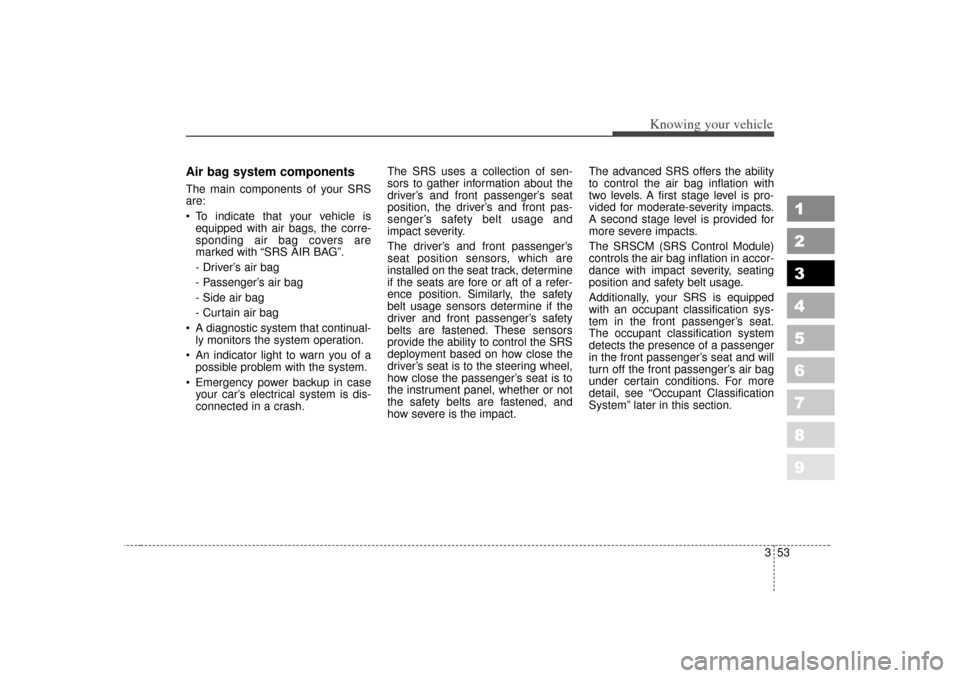
353
1
2
3
4
5
6
7
8
9
Knowing your vehicle
Air bag system components The main components of your SRS
are:
To indicate that your vehicle is
equipped with air bags, the corre-
sponding air bag covers are
marked with “SRS AIR BAG”.
- Driver’ s air bag
- Passenger’ s air bag
- Side air bag
- Curtain air bag
A diagnostic system that continual-
ly monitors the system operation.
An indicator light to warn you of a
possible problem with the system.
Emergency power backup in case
your car’ s electrical system is dis-
connected in a crash. The SRS uses a collection of sen-
sors to gather information about the
driver’
s and front passenger’ s seat
position, the driver’ s and front pas-
senger’ s safety belt usage and
impact severity.
The driver’ s and front passenger’ s
seat position sensors, which are
installed on the seat track, determine
if the seats are fore or aft of a refer-
ence position. Similarly, the safety
belt usage sensors determine if the
driver and front passenger’ s safety
belts are fastened. These sensors
provide the ability to control the SRS
deployment based on how close the
driver’ s seat is to the steering wheel,
how close the passenger’ s seat is to
the instrument panel, whether or not
the safety belts are fastened, and
how severe is the impact. The advanced SRS offers the ability
to control the air bag inflation with
two levels. A first stage level is pro-
vided for moderate-severity impacts.
A second stage level is provided for
more severe impacts.
The SRSCM (SRS Control Module)
controls the air bag inflation in accor-
dance with impact severity, seating
position and safety belt usage.
Additionally, your SRS is equipped
with an occupant classification sys-
tem in the front passenger’
s seat.
The occupant classification system
detects the presence of a passenger
in the front passenger’ s seat and will
turn off the front passenger ’s air bag
under certain conditions. For more
detail, see “Occupant Classification
System” later in this section.
Page 64 of 300
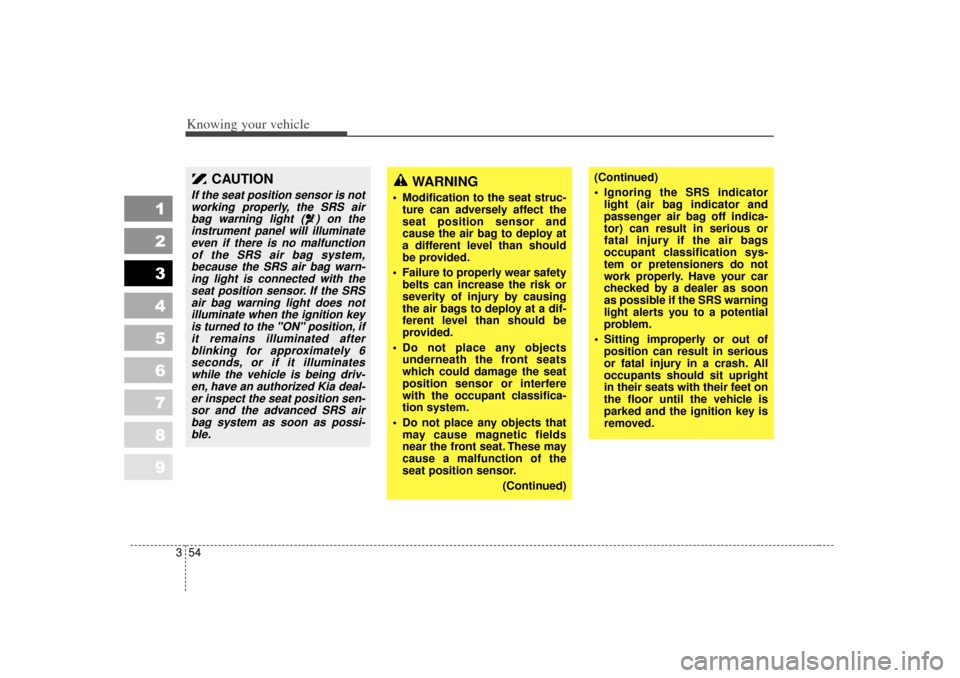
Knowing your vehicle54
3
1
2
3
4
5
6
7
8
9
CAUTION
If the seat position sensor is not
working properly, the SRS airbag warning light ( ) on theinstrument panel will illuminateeven if there is no malfunctionof the SRS air bag system,because the SRS air bag warn-ing light is connected with theseat position sensor. If the SRSair bag warning light does notilluminate when the ignition keyis turned to the "ON" position, ifit remains illuminated afterblinking for approximately 6seconds, or if it illuminateswhile the vehicle is being driv-en, have an authorized Kia deal-er inspect the seat position sen-sor and the advanced SRS airbag system as soon as possi-ble.
WARNING
Modification to the seat struc- ture can adversely affect the
seat position sensor and
cause the air bag to deploy at
a different level than should
be provided.
Failure to properly wear safety belts can increase the risk or
severity of injury by causing
the air bags to deploy at a dif-
ferent level than should be
provided.
Do not place any objects underneath the front seats
which could damage the seat
position sensor or interfere
with the occupant classifica-
tion system.
Do not place any objects that may cause magnetic fields
near the front seat. These may
cause a malfunction of the
seat position sensor.
(Continued)
(Continued)
Ignoring the SRS indicatorlight (air bag indicator and
passenger air bag off indica-
tor) can result in serious or
fatal injury if the air bags
occupant classification sys-
tem or pretensioners do not
work properly. Have your car
checked by a dealer as soon
as possible if the SRS warning
light alerts you to a potential
problem.
Sitting improperly or out of position can result in serious
or fatal injury in a crash. All
occupants should sit upright
in their seats with their feet on
the floor until the vehicle is
parked and the ignition key is
removed.
Page 65 of 300
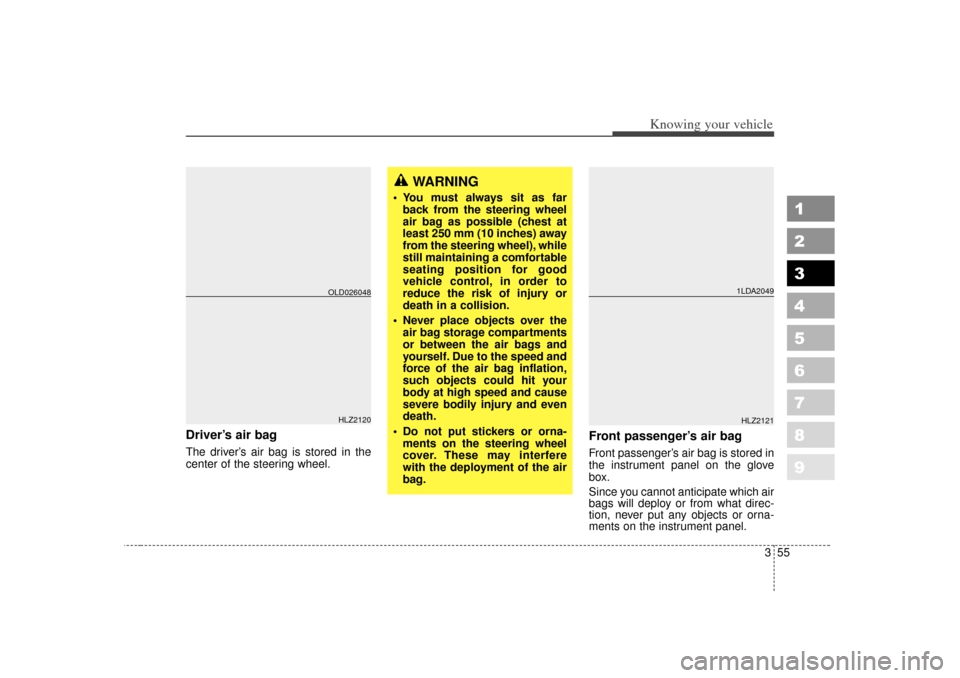
355
1
2
3
4
5
6
7
8
9
Knowing your vehicle
Driver’s air bagThe driver’s air bag is stored in the
center of the steering wheel.
Front passenger’s air bagFront passenger’ s air bag is stored in
the instrument panel on the glove
box.
Since you cannot anticipate which air
bags will deploy or from what direc-
tion, never put any objects or orna-
ments on the instrument panel.
WARNING
You must always sit as far back from the steering wheel
air bag as possible (chest at
least 250 mm (10 inches) away
from the steering wheel), while
still maintaining a comfortable
seating position for good
vehicle control, in order to
reduce the risk of injury or
death in a collision.
Never place objects over the air bag storage compartments
or between the air bags and
yourself. Due to the speed and
force of the air bag inflation,
such objects could hit your
body at high speed and cause
severe bodily injury and even
death.
Do not put stickers or orna- ments on the steering wheel
cover. These may interfere
with the deployment of the air
bag.
HLZ2120OLD026048
1LDA2049HLZ2121
Page 66 of 300

Knowing your vehicle56
3
1
2
3
4
5
6
7
8
9
Occupant classification systemThe occupant classification system
detects the presence of a passenger
in the front passenger's seat and will
turn off the front passenger's air bag
under certain conditions.
The occupant classification system is
designed to detect the presence of a
properly-seated occupant and deter-
mine if the front passenger's air bag
should be enabled (may inflate) or
not.
Only the front passenger air bag is
controlled by the Occupant
Classification System.
Main components of occupant
classification system A detection device located within
the front passenger seat cushion.
Electronic system to determine
whether passenger air bag system
should be activated or deactivated.
A indicator light located on the
instrument panel which illuminates
the words "PASSENGER AIR BAG
OFF" indicating the frontal passen-
ger air bag system is deactivated.
The instrument panel air bag warn-
ing light is interconnected with the
occupant classification system. If there is no passenger in the front
passenger seat or if the passenger in
the front passenger seat is very light,
(such as a child), the front
PASSEN-
GER AIR BAG OFF indicator may
illuminate.
When this indicator is ON, the front
passenger front air bag will not
deploy.
1LDN2166
OLD036150N
The location of OCS Indicator
Page 67 of 300
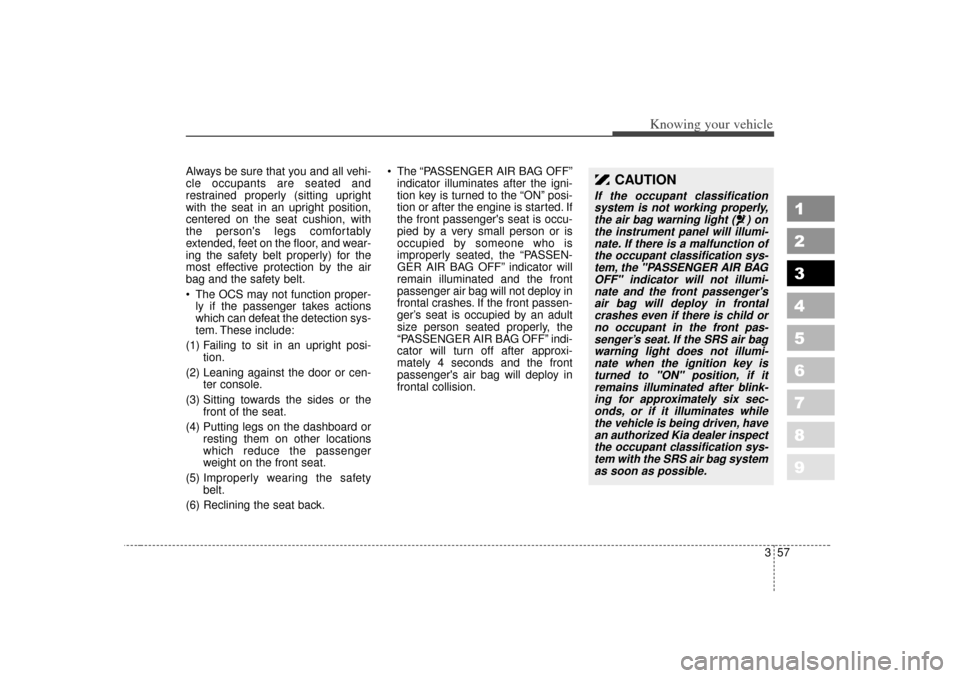
357
1
2
3
4
5
6
7
8
9
Knowing your vehicle
Always be sure that you and all vehi-
cle occupants are seated and
restrained properly (sitting upright
with the seat in an upright position,
centered on the seat cushion, with
the person's legs comfortably
extended, feet on the floor, and wear-
ing the safety belt properly) for the
most effective protection by the air
bag and the safety belt.
The OCS may not function proper-
ly if the passenger takes actions
which can defeat the detection sys-
tem. These include:
(1) Failing to sit in an upright posi- tion.
(2) Leaning against the door or cen- ter console.
(3) Sitting towards the sides or the front of the seat.
(4) Putting legs on the dashboard or resting them on other locations
which reduce the passenger
weight on the front seat.
(5) Improperly wearing the safety
belt.
(6) Reclining the seat back.
The “PASSENGER AIR BAG OFF”
indicator illuminates after the igni-
tion key is turned to the “ON”posi-
tion or after the engine is started. If
the front passenger's seat is occu-
pied by a very small person or is
occupied by someone who is
improperly seated, the “PASSEN-
GER AIR BAG OFF” indicator will
remain illuminated and the front
passenger air bag will not deploy in
frontal crashes. If the front passen-
ger’ s seat is occupied by an adult
size person seated properly, the
“PASSENGER AIR BAG OFF” indi-
cator will turn off after approxi-
mately 4 seconds and the front
passenger's air bag will deploy in
frontal collision.
CAUTION
If the occupant classification system is not working properly,the air bag warning light ( ) onthe instrument panel will illumi-nate. If there is a malfunction ofthe occupant classification sys-tem, the "PASSENGER AIR BAGOFF" indicator will not illumi-nate and the front passenger'sair bag will deploy in frontalcrashes even if there is child orno occupant in the front pas-senger’s seat. If the SRS air bagwarning light does not illumi-nate when the ignition key isturned to "ON" position, if itremains illuminated after blink-ing for approximately six sec-onds, or if it illuminates whilethe vehicle is being driven, havean authorized Kia dealer inspectthe occupant classification sys-tem with the SRS air bag systemas soon as possible.
Page 68 of 300
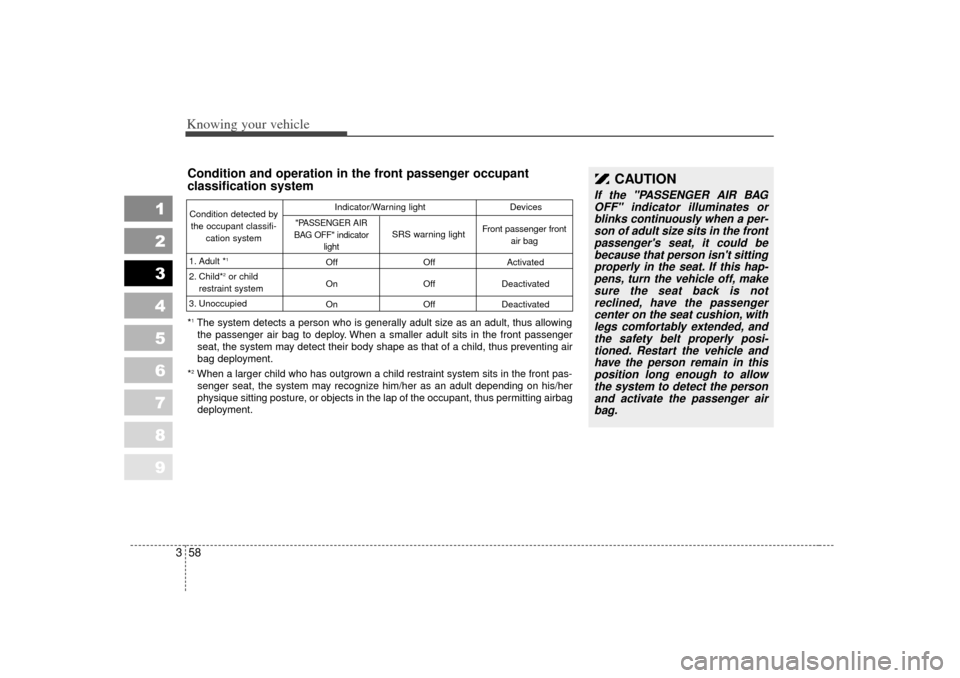
Knowing your vehicle58
3
1
2
3
4
5
6
7
8
9
Condition and operation in the front passenger occupant
classification systemCondition detected by
the occupant classifi- cation system
1. Adult *
1
2. Child*
2or child
restraint system
3. Unoccupied Off
On
On Off
Off
OffActivated
Deactivated
Deactivated
"PASSENGER AIR
BAG OFF" indicator light
SRS warning light Front passenger front
air bag
Indicator/Warning light
Devices
*1The system detects a person who is generally adult size as an adult, thus allowing
the passenger air bag to deploy. When a smaller adult sits in the front passenger
seat, the system may detect their body shape as that of a child, thus preventing air
bag deployment.
*2When a larger child who has outgrown a child restraint system sits in the front pas- senger seat, the system may recognize him/her as an adult depending on his/her
physique sitting posture, or objects in the lap of the occupant, thus permitting airbag
deployment.
CAUTION
If the "PASSENGER AIR BAG OFF" indicator illuminates orblinks continuously when a per-son of adult size sits in the frontpassenger's seat, it could bebecause that person isn't sittingproperly in the seat. If this hap-pens, turn the vehicle off, makesure the seat back is notreclined, have the passengercenter on the seat cushion, withlegs comfortably extended, andthe safety belt properly posi-tioned. Restart the vehicle andhave the person remain in thisposition long enough to allowthe system to detect the personand activate the passenger airbag.
Page 69 of 300
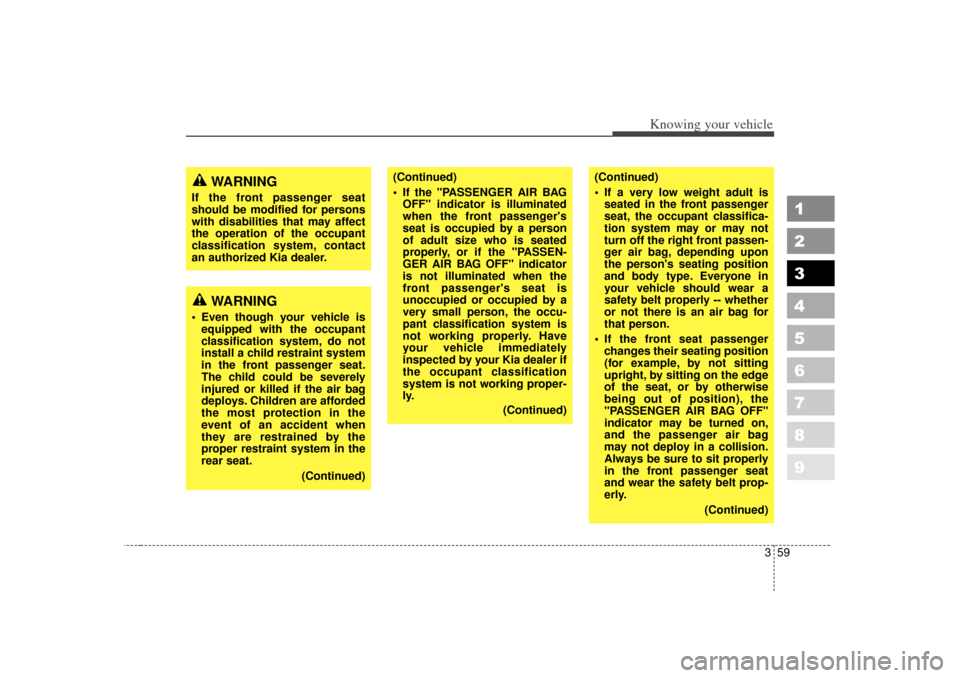
359
1
2
3
4
5
6
7
8
9
Knowing your vehicle
(Continued)
If the "PASSENGER AIR BAGOFF" indicator is illuminated
when the front passenger's
seat is occupied by a person
of adult size who is seated
properly, or if the "PASSEN-
GER AIR BAG OFF" indicator
is not illuminated when the
front passenger's seat is
unoccupied or occupied by a
very small person, the occu-
pant classification system is
not working properly. Have
your vehicle immediately
inspected by your Kia dealer if
the occupant classification
system is not working proper-
ly.
(Continued)
(Continued)
If a very low weight adult isseated in the front passenger
seat, the occupant classifica-
tion system may or may not
turn off the right front passen-
ger air bag, depending upon
the person's seating position
and body type. Everyone in
your vehicle should wear a
safety belt properly -- whether
or not there is an air bag for
that person.
If the front seat passenger changes their seating position
(for example, by not sitting
upright, by sitting on the edge
of the seat, or by otherwise
being out of position), the
"PASSENGER AIR BAG OFF"
indicator may be turned on,
and the passenger air bag
may not deploy in a collision.
Always be sure to sit properly
in the front passenger seat
and wear the safety belt prop-
erly.
(Continued)
WARNING
If the front passenger seat
should be modified for persons
with disabilities that may affect
the operation of the occupant
classification system, contact
an authorized Kia dealer.
WARNING
Even though your vehicle isequipped with the occupant
classification system, do not
install a child restraint system
in the front passenger seat.
The child could be severely
injured or killed if the air bag
deploys. Children are afforded
the most protection in the
event of an accident when
they are restrained by the
proper restraint system in the
rear seat.
(Continued)
Page 70 of 300

Knowing your vehicle60
3
1
2
3
4
5
6
7
8
9
1KMN36631KMN3664
- Never sit with hips shifted
towards the front of the seat.
- Never lean on the center con- sole.
- Never sit on one side of the front passenger seat.
(Continued)
(Continued)
1KMN36651KMN3666
- Always sit in a proper seatingposition.
- Never place feet on the dash-
board.
1KMN36611KMN3662
- Never put a heavy load in thefront passenger seat.
- Never excessively recline the front passenger seatback.